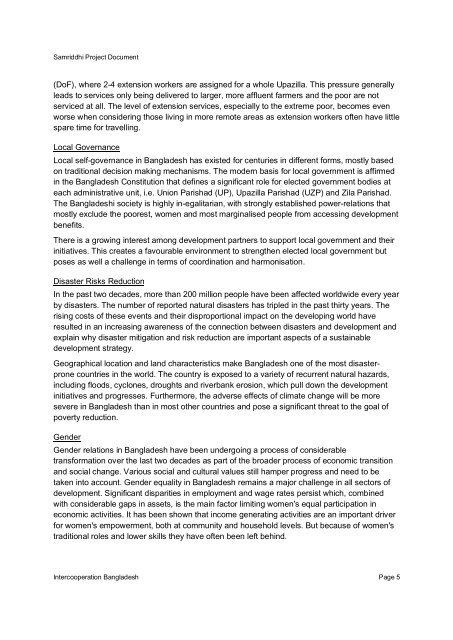Samriddhi
Samriddhi
Samriddhi
Create successful ePaper yourself
Turn your PDF publications into a flip-book with our unique Google optimized e-Paper software.
<strong>Samriddhi</strong> Project Document<br />
(DoF), where 2-4 extension workers are assigned for a whole Upazilla. This pressure generally<br />
leads to services only being delivered to larger, more affluent farmers and the poor are not<br />
serviced at all. The level of extension services, especially to the extreme poor, becomes even<br />
worse when considering those living in more remote areas as extension workers often have little<br />
spare time for travelling.<br />
Local Governance<br />
Local self-governance in Bangladesh has existed for centuries in different forms, mostly based<br />
on traditional decision making mechanisms. The modern basis for local government is affirmed<br />
in the Bangladesh Constitution that defines a significant role for elected government bodies at<br />
each administrative unit, i.e. Union Parishad (UP), Upazilla Parishad (UZP) and Zila Parishad.<br />
The Bangladeshi society is highly in-egalitarian, with strongly established power-relations that<br />
mostly exclude the poorest, women and most marginalised people from accessing development<br />
benefits.<br />
There is a growing interest among development partners to support local government and their<br />
initiatives. This creates a favourable environment to strengthen elected local government but<br />
poses as well a challenge in terms of coordination and harmonisation.<br />
Disaster Risks Reduction<br />
In the past two decades, more than 200 million people have been affected worldwide every year<br />
by disasters. The number of reported natural disasters has tripled in the past thirty years. The<br />
rising costs of these events and their disproportional impact on the developing world have<br />
resulted in an increasing awareness of the connection between disasters and development and<br />
explain why disaster mitigation and risk reduction are important aspects of a sustainable<br />
development strategy.<br />
Geographical location and land characteristics make Bangladesh one of the most disasterprone<br />
countries in the world. The country is exposed to a variety of recurrent natural hazards,<br />
including floods, cyclones, droughts and riverbank erosion, which pull down the development<br />
initiatives and progresses. Furthermore, the adverse effects of climate change will be more<br />
severe in Bangladesh than in most other countries and pose a significant threat to the goal of<br />
poverty reduction.<br />
Gender<br />
Gender relations in Bangladesh have been undergoing a process of considerable<br />
transformation over the last two decades as part of the broader process of economic transition<br />
and social change. Various social and cultural values still hamper progress and need to be<br />
taken into account. Gender equality in Bangladesh remains a major challenge in all sectors of<br />
development. Significant disparities in employment and wage rates persist which, combined<br />
with considerable gaps in assets, is the main factor limiting women's equal participation in<br />
economic activities. It has been shown that income generating activities are an important driver<br />
for women's empowerment, both at community and household levels. But because of women's<br />
traditional roles and lower skills they have often been left behind.<br />
Intercooperation Bangladesh Page 5
















